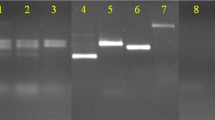Abstract
The bacterial plant pathogen Xylella fastidiosa causes disease in hundreds of plant species worldwide including many crops, and as such accurate determination of the subspecies of the bacteria is vital to control, containment, and eradication measures. Conventional methods to determine the subspecies of X. fastidiosa rely on time consuming multilocus sequence typing (MLST), a laborious multistage process. This chapter provides a rapid alternative to MLST utilizing real-time PCR assays to provide highly specific and sensitive detection of the pathogen subspecies. Here we describe the methodology for sampling plant material, performing the DNA extraction and undertaking the real-time PCR assays. This method allows straightforward, robust, reliable, high-throughput, and rapid determination of the X. fastidiosa subspecies.
Access this chapter
Tax calculation will be finalised at checkout
Purchases are for personal use only
Similar content being viewed by others
References
Wells JM, Raju BC, Hung HY et al (1987) Xylella fastidiosa gen. nov., sp. nov: gram-negative, xylem-limited, fastidious plant bacteria related to Xanthomonas spp. Int J Syst Evol Microbiol 37(2):136–143
Jacques MA, Denancé N, Legendre B et al (2016) New coffee plant-infecting Xylella fastidiosa variants derived via homologous recombination. Appl Environ Microbiol 82(5):1556–1568
Janse JD, Obradovic A (2010) Xylella fastidiosa: its biology, diagnosis, control and risks. J Plant Pathol 92:S35–S48
Saponari M, Boscia D, Nigro F et al (2013) Identification of DNA sequences related to Xylella fastidiosa in oleander, almond and olive trees exhibiting leaf scorch symptoms in Apulia (Southern Italy). J Plant Pathol 95(3):668
European Commission (2018) Latest Developments of Xylella fastidiosa in the EU territory. [ONLINE] Available at: https://ec.europa.eu/food/plant/plant_health_biosecurity/legislation/emergency_measures/xylella-fastidiosa/latest-developments_en. Accessed 25 Sept 2021
EFSA PLH Panel (EFSA Panel on Plant Health) (2015) Scientific Opinion on the risks to plant health posed by Xylella fastidiosa in the EU territory, with the identification and evaluation of risk reduction options. EFSA J 13(1):3989
Schaad NW, Postnikova E, Lacy G (2004) Xylella fastidiosa subspecies: X. fastidiosa subsp piercei, subsp. nov., X. fastidiosa subsp. multiplex subsp. nov., and X. fastidiosa subsp. pauca subsp. nov. Syst Appl Microbiol 27(3): 290-300. Erratum. Syst Appl Microbiol 27(6):763
Schuenzel EL, Scally M, Stouthamer R et al (2005) A multigene phylogenetic study of clonal diversity and divergence in North American strains of the plant pathogen Xylella fastidiosa. Appl Environ Microbiol 71(7):3832–3839
Nunney L, Schuenzel EL, Scally M et al (2014) Large scale intersubspecific recombination in the plant pathogenic bacterium Xylella fastidiosa is associated with the host shift to mulberry. Appl Environ Microbiol 80(10):3025–3033
Rubio S, Barnes A, Webb K (2017) A real‐time PCR assay for improved rapid, specific detection of Cryphonectria parasitica. Ann Appl Biol 171(1):52–61
Hodgetts J, Glover R, Cole J et al (2021) Genomics informed design of a suite of real‐time PCR assays for the specific detection of each Xylella fastidiosa subspecies. J Appl Microbiol 131(2):855–872
Harper SJ, Ward LI, Clover GRG (2010) Development of LAMP and real-time PCR methods for the rapid detection of Xylella fastidiosa for quarantine and field applications. Phytopathology 100:1282–1288. Erratum 2013
Weller SA, Elphinstone JG, Smith NC et al (2000) Detection of Ralstonia solanacearum strains with a quantitative, multiplex, real-time, fluorogenic PCR (TaqMan) assay. Appl Environ Microbiol 66:2853–2858
Hughes KJ, Tomlinson JA, Griffin RL et al (2006) Development of a one-step real-time polymerase chain reaction assay for diagnosis of Phytophthora ramorum. Phytopathology 96:975–981
Doyle JJ, Doyle JL (1990) Isolation of plant DNA from fresh tissue. Focus 12:13–15
EPPO (European and Mediterranean Plant Protection Organization) (2019a) PM 7/24 (4) Xylella fastidiosa. Bulletin OEPP 49(2):175–227
EPPO (European and Mediterranean Plant Protection Organization) (2019b) PM 7/98 (4) Specific requirements for laboratories preparing accreditation for a plant pest diagnostic activity. Bulletin OEPP 49(3):530–563
EPPO (European and Mediterranean Plant Protection Organization) (2020a) PM 3/81 (2) Inspection of consignments for Xylella fastidiosa. Bulletin OEPP 50(3):401–414
EPPO (European and Mediterranean Plant Protection Organization) (2020b) PM 3/82 (2) Inspection of places of production for Xylella fastidiosa. Bulletin OEPP 50(3):415–428
Author information
Authors and Affiliations
Corresponding author
Editor information
Editors and Affiliations
Rights and permissions
Copyright information
© 2022 The Author(s), under exclusive license to Springer Science+Business Media, LLC, part of Springer Nature
About this protocol
Cite this protocol
Hodgetts, J. (2022). A Panel of Real-Time PCR Assays for the Direct Detection of All of the Xylella fastidiosa Subspecies. In: Luchi, N. (eds) Plant Pathology. Methods in Molecular Biology, vol 2536. Humana, New York, NY. https://doi.org/10.1007/978-1-0716-2517-0_13
Download citation
DOI: https://doi.org/10.1007/978-1-0716-2517-0_13
Published:
Publisher Name: Humana, New York, NY
Print ISBN: 978-1-0716-2516-3
Online ISBN: 978-1-0716-2517-0
eBook Packages: Springer Protocols




